Por favor, hagan un llamado a la Cancillería y avísenle a @JorgeFaurie que se metió de contramano. El mundo va para otro lado! 😂#ArgentinaExporta @fvallejoss @jsfraschina @tanomalic @Lupo55 https://t.co/6AbAumcNAY— Federico Vaccarezza (@FeVaccarezza) July 24, 2019
Las medidas restrictivas del comercio se mantienen en un nivel excepcionalmente alto
Las corrientes comerciales afectadas por las nuevas restricciones impuestas por los Miembros de la OMC se mantuvieron en un nivel excepcionalmente alto entre mediados de octubre de 2018 y mediados de mayo de 2019, según el último informe de mediados de año del Director General sobre los hechos relacionados con el comercio, presentado a los Miembros el 22 de julio. En el informe, que se examinó en una reunión del Órgano de Examen de las Políticas Comerciales de la OMC, se señala que el valor del comercio abarcado por las medidas restrictivas de las importaciones aplicadas durante el período objeto de examen se estima en USD 339.500 millones. Esta es la segunda cifra más alta de la que hay constancia, tras los USD 588.300 millones de dólares registrados en el período anterior. En conjunto, esos dos períodos revelan un acusado aumento del comercio abarcado por medidas de restricción de las importaciones.
ACUERDO HISTÓRICO ENTRE UNIÓN EUROPEA Y MERCOSUR— Mauricio Macri (@mauriciomacri) June 28, 2019
El emocionado audio que me envió el canciller Jorge Faurie. pic.twitter.com/lWCfVyrmO9
Informe del Director General al OEPC sobre los hechos ocurridos recientemente en relación con el comercio
(de momento sólo en inglés)
"The overall picture is concerning. The report provides evidence that trade tensions continue to dominate the global trade environment," said Director-General Roberto Azevêdo in presenting the report, where he urged WTO members to work together to help scale back the situation. "The message of the report before us is very serious. These actions have real economic effects, and the alarm bells are already sounding. It is essential that we tackle the tensions that are leading to higher trade barriers, greater uncertainty and lower trade growth. Exercises like this can only help in those efforts," DG Azevêdo added.
The Director-General's full speech to launch the report is available here.
The report shows that trade tensions continued to dominate the headlines and add to the uncertainty surrounding international trade and the world economy, with G20 economies accounting for the overwhelming share of the trade coverage of import-restrictive measures during the review period. It also provides evidence that this turbulence is continuing after the previous period (between mid-October 2017 and mid-October 2018) saw a record level of new restrictive measures introduced (USD 588.3 billion). Most of these measures remain in place and have now been added to by a series of new measures in the current period which are also at a historically high level.
The report shows that WTO members applied 38 new trade-restrictive measures during the review period mainly through tariff increases, import bans, special safeguards, import taxes and export duties. The trade coverage of import-restrictive measures implemented between mid-October 2018 and mid-May 2019 is estimated at USD 339.5 billion - 44% above the average since October 2012 when the report started including trade coverage figures. The report also notes that several significant trade-restrictive measures either will be implemented shortly after the period covered or remain under consultation for potential later implementation, suggesting that the precarious situation in global trade will persist.
WTO members also implemented 47 new measures aimed at facilitating trade during the review period, including eliminating or reducing import tariffs, eliminating or simplifying customs procedures for exports and reducing import taxes. At almost seven new trade-facilitating measures per month, this is the lowest monthly average registered since 2012. The trade coverage of the import- facilitating measures implemented during the review period was estimated at USD 398.2 billion.
During the review period, and for the first time since 2012, the number of terminations of trade remedy investigations by WTO members outpaced the number of initiations of trade remedy actions. Sixteen trade remedy terminations per month and 14 trade remedy initiations were recorded, with the latter being the lowest monthly average registered since 2012. Initiations of anti-dumping investigations continued to be the most frequent trade remedy action, accounting for three-quarters of all initiations. The trade coverage of trade remedy initiations recorded is estimated at USD 20.2 billion and that of trade remedy terminations at USD 16.4 billion.
At this critical juncture, the report calls on WTO members to follow through on their commitment to trade and to the rules-based international trading system and work together urgently to ease trade tensions and to improve and strengthen the WTO.
Key findings
- This Report covers new trade and trade-related measures implemented by WTO members between 16 October 2018 and 15 May 2019. During this period, trade tensions continued to dominate the headlines and added to the uncertainty surrounding international trade and the world economy.
- The Report provides evidence that this turbulence is continuing. The previous period saw a record level of new restrictive measures introduced. Most of these measures remain in place and have now been added to by a series of new measures in the current period which are also of a historically high level.
- The trade coverage of import-restrictive measures during the period is estimated at USD 339.5 billion. This is the second-highest figure on record, after the USD 588.3 billion reported in the previous period. Together these two periods represent a dramatic spike in the trade coverage of import-restrictive measures. The downward trend identified between mid-October 2014 and mid-October 2017 has been replaced with a steep increase in the trade coverage of import-restrictive measures.
- The Report also notes that several significant trade-restrictive measures, which fall outside of the review period, remain under consultation for potential later implementation. This further compounds the challenges faced by governments, businesses and consumers in the current global economic environment.
- In terms of the number of measures introduced, WTO members implemented 38 new trade-restrictive measures during the review period including tariff increases, import bans, special safeguards, import taxes and export duties. While fewer measures were introduced during this review period than in previous periods, the scale of those measures is much increased in terms of their trade coverage and the level of tariffs imposed. Trade measures implemented by G20 economies account for the overwhelming share of the trade coverage of import-restrictive measures recorded in this Report.
- WTO members also implemented 47 new measures aimed at facilitating trade during the review period, including eliminating or reducing import tariffs, eliminating or simplifying customs procedures for exports and reducing import taxes. The trade coverage of the import-facilitating measures implemented during the review period was estimated at USD 398.2 billion.
- The monthly average of 14 initiations of trade remedy actions during the review period is the lowest registered since 2012. The trade coverage of trade remedy initiations (USD 20.2 billion) has fallen significantly compared to the previous period. The trade coverage of trade remedy terminations recorded in the review period (USD 16.4 billion) has also fallen compared to the previous Report.
- This Report highlights the continuing challenges in global trade. Collectively, WTO members must follow through on their commitment to trade and to the rules-based international trading system and work together urgently to ease trade tensions and to improve and strengthen the WTO.
Trade coverage of new import-restrictive measures in each reporting period (not cumulative)
(USD billion)
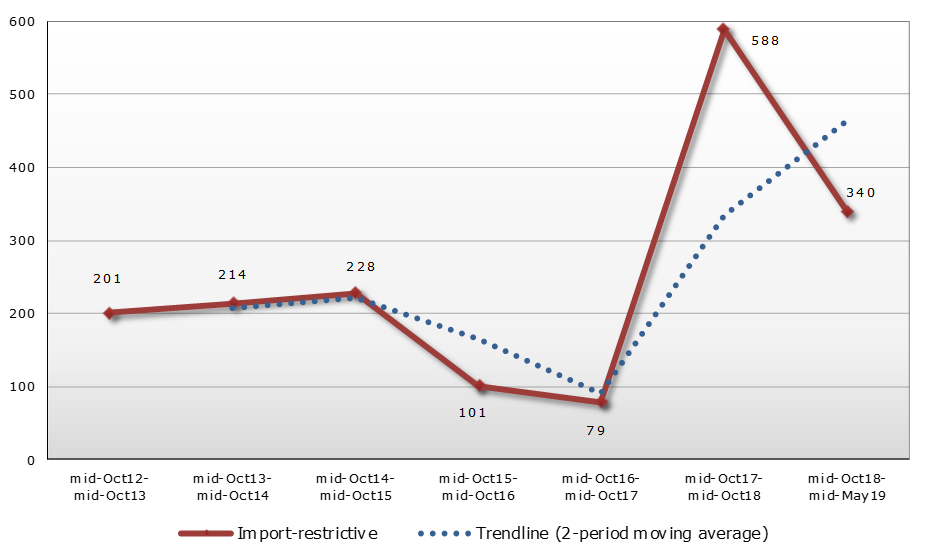
Note: These figures are estimates and represent the trade coverage of the measures (i.e. annual imports of the products concerned from economies affected by the measures) introduced during each reporting period and not the impact of the trade measures. The chart provides a snapshot of the new measures introduced in each period, not the cumulative impact of the measures introduced over time.
Source: WTO Secretariat.
Source: WTO Secretariat.
Trade coverage of new import-facilitating measures in each reporting period (not cumulative)
(USD billion)
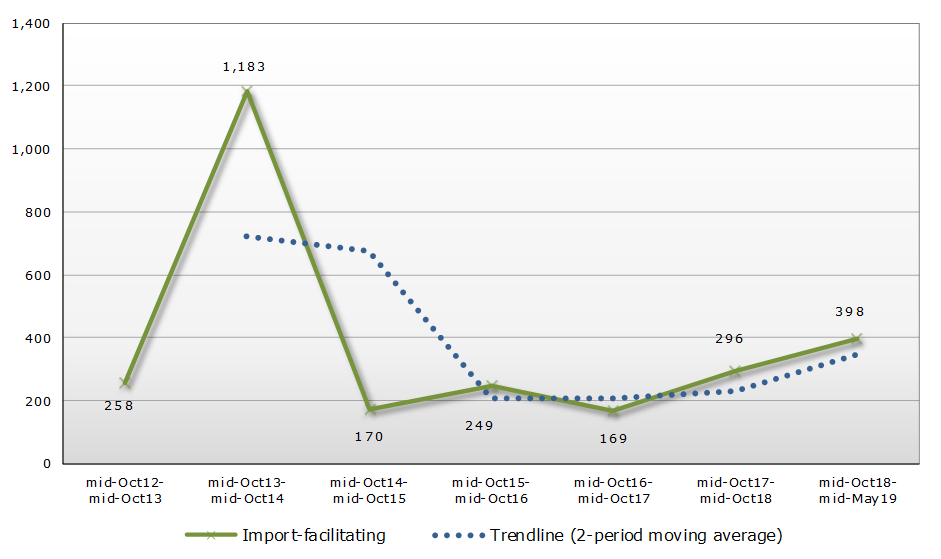
Note: These figures are estimates and represent the trade coverage of the measures (i.e. annual imports of the products concerned from economies affected by the measures) and not the impact of the trade measures. Liberalization associated with the 2015 Expansion of the WTO's Information Technology Agreement is not included in the figures.
Source: WTO Secretariat.
Source: WTO Secretariat.
Trade-restrictive measures
(Average per month)
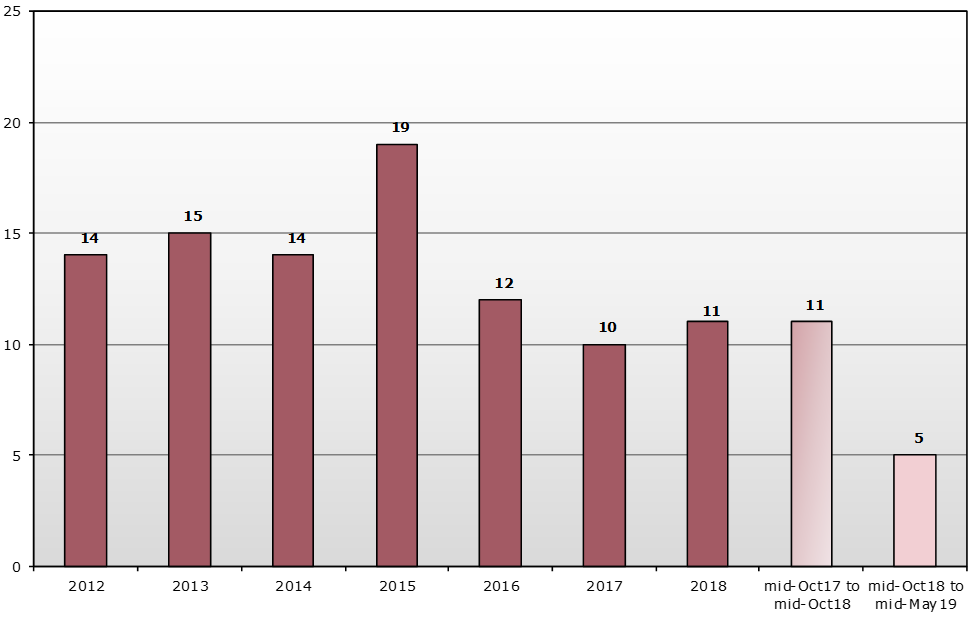
Note: Values are rounded. Changes to averages of previous years reflect continuing fine tuning of, and updates to, the TMDB.
Source: WTO Secretariat.
Source: WTO Secretariat.
Trade-facilitating measures
(Average per month)
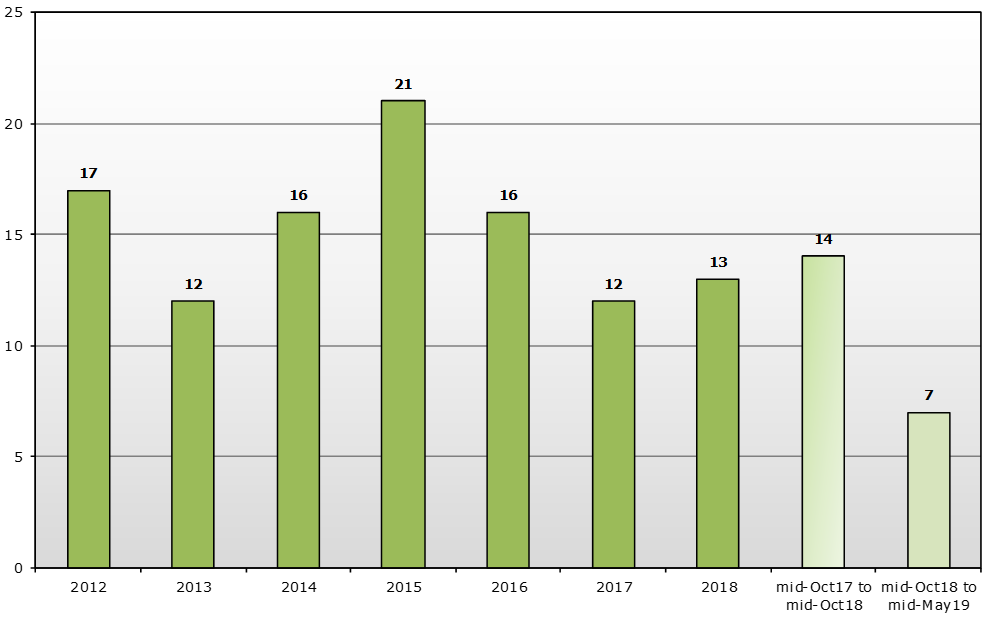
Note: Values are rounded. Changes to averages of previous years reflect continuing fine tuning of, and updates to, the TMDB.
Source: WTO Secretariat.
Source: WTO Secretariat.
WTO trade remedies initiations and terminations
(Average per month)
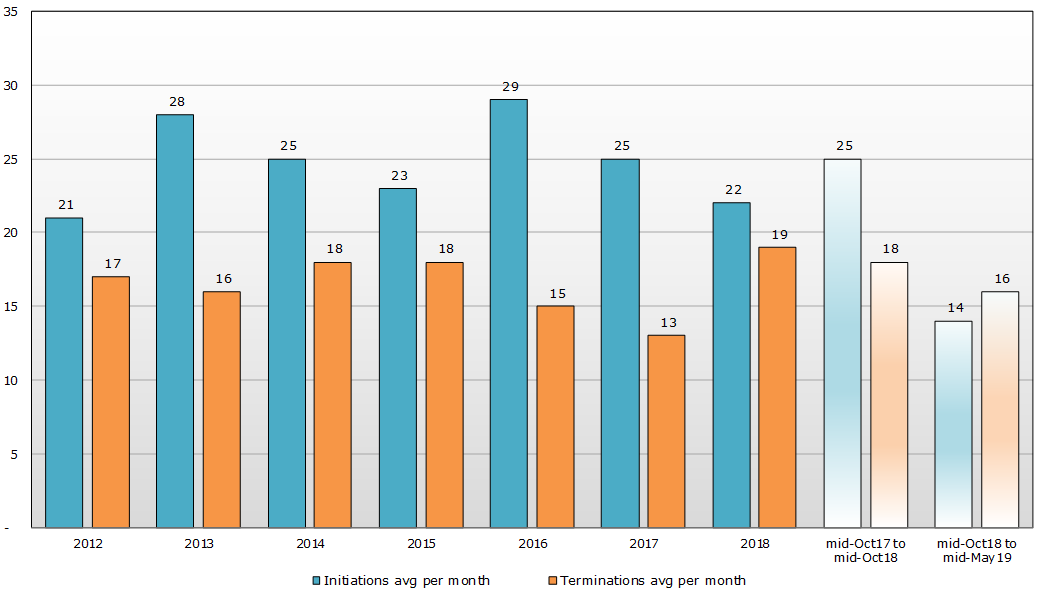
Note: Values are rounded.
Source: WTO Secretariat.
Source: WTO Secretariat.
Trade measures, mid-October 2018 to mid-May 2019
(By number)

Source: WTO Secretariat.
Trade coverage of import measures, mid-October 2018 to mid-May 2019
(USD billion)

Note: 2017 figures. ITA expansion measures are not included.
Source: WTO Secretariat.
Source: WTO Secretariat.

1 comentario:
"El Cambio" trabaja sobre el imaginario de un "pasado tenebroso", quizás un"segundo aluvión zoológico" y un "pasado glorioso cómo granero del mundo". Eso podría justificar la adhesión que obtiene entre "los campestres" y los jubilados.
Publicar un comentario